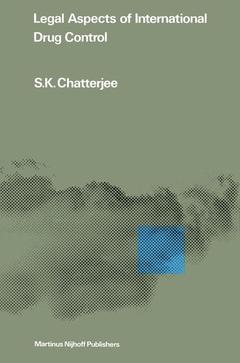Description
Legal Aspects of International Drug Control, Softcover reprint of the original 1st ed. 1981
Author: Chatterjee S.K.
Language: English
Keywords
Administration; China; controlling; drugs; evaluation; international law; law; organization; production; rehabilitation; survey; tax on wages; training
Publication date: 01-1981
587 p. · 15.5x23.5 cm · Paperback
587 p. · 15.5x23.5 cm · Paperback
Description
/li>Contents
/li>
The need for suppressing the illicit traffic in drugs can hardly be over-emphasized. Yet, the licit uses of drugs, especially for medical and scientific needs, cannot be suppressed. Apparently, it is a ques tion of determining the vvorld requirements of drugs for such legiti mate uses, and of producing and manufacturing them accordingly. Owing to their multifarious medical uses in various parts of the world, it proves to be almost impossible to determine exactly the amount of drugs required for legitimate purposes. There is also the complicating factor that drugs are used for sociological and religious reasons, which have a long history. Not only arc the licit uses and legitimate amounts of drugs difficult to determine but also such difficulties give rise to illicit traffic in them. Yet, it is believed that a concerted international policy, coupled with national co-operation, on various facets of the related problems-namely, limitation of production and/or manufacture of drugs, restriction on cultivation of plants that may contribute to addiction-producing substances, training and rehabilitation of drug addicts, and efficient national administration-would help eradicate drug-abuse. In search of an appropriate remedy, this book has been devoted to a practical study of the problem and to exploring, in this area of international law, the relationship between the political and econ omic interests and the international economic order.
I A Survey of the History of Drug-Use and Early Moves Towards International Control.- 1: Social and Cultural Aspects of Drug-Use and Historical Origins of the Use of Opium.- 2: International Action for the Control of Trade and Traffic in Drugs between 1909 and 1919.- II International Action for the Control of Trade and Traffic in Drugs between 1920 and 1944.- 3: The Organizational and Functional Framework as Devised by the League of Nations for the Purpose of Controlling the Manufacture of, and Trade and Traffic in, Drugs.- 4: An Examination of the Agreements and Conventions on Opium and Other Dangerous Drugs Concluded between 1920 and 1944.- III The Structure and Methods of International Drug Control through the United Nations.- 5: The Organizational Framework of the United Nations in Relation to the Control of Drugs.- 6: An Examination of the Drug Protocols Concluded During the UN Period (Prior to the Single Convention on Narcotic Drugs, 1961).- 7: An Examination of the Single Convention on Narcotic Drugs, 1961.- 8: Limitation on Cultivation.- 9: Limitation on the Production of Opium.- 10: Manufacture and Importation of Drugs: Limitation Thereof.- 11: Control of Illicit Trade and Traffic in Narcotic Drugs.- 12: An Examination of the Convention on Psychotropic Substances, 1971.- IV Contributions of Some of the Inter-Governmental and International Non-Governmental Organizations Concerned with the Eradication of Illicit Trade and Traffic in Narcotic Drugs.- 13: The Organization and Functions of Interpol and the Ingos in the Control of the Drug-Trade.- Conclusions.- League of Nations Documents.- United Nations Documents.- World Health Organization Technical Report Series.- Miscellaneous Documents.- Table of Cases.- Appendices.
© 2024 LAVOISIER S.A.S.




